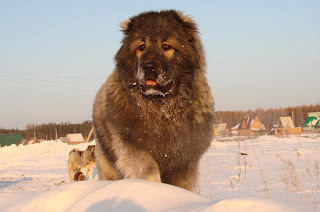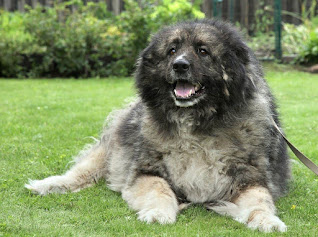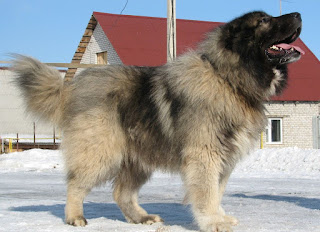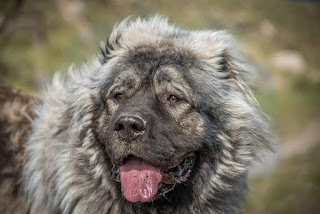Caucasian shepherd dog similar breeds - In Wikipedia it is easy to find a mention of the Caucasian Shepherd among breeds of dogs - wolfhounds.
However, other representatives of the Caucasian Shepherd Dog are also listed there. Only they call them Armenian, Georgian and Azerbaijani wolfhounds. In addition, you can often hear about other wolfhounds of the peoples of the Caucasus. For example, Dagestan, Turkish, Iranian. But the Caucasian Shepherd among them is mentioned as a separate breed, which raises a lot of questions. All these breeds are not related to the Caucasian Shepherd Dog? Or it's individual breeds. We will not delve into the ancient history of their origin yet. I would understand the contradictory information already more modern period. It seems that the encyclopedic books on dog breeding even soviet times are already quite outdated. So individual is it a breed or not? And why can all Caucasian Shepherds be so different?
Due to the widespread distribution of the Caucasian Shepherd breed in different territories, they acquired external differences. So there were types of Caucasian Shepherd, differing regions in which they lived. That is, the climate and landscape have had an impact on the formation of appearance, as well as the character and habits of these dogs. For centuries the breed has changed, and many types and subtypes within it have formed. After the end of the Civil War, for the first time, cynologists began to organize and describe the types of people.
There are several types of Caucasian shepherds, which are then divided into small subgroups:
1. Georgian type. Caucasian Shepherds of the Georgian region have a mighty backbone, they are the largest of all other types. The constitution is strong and rough, the head is in the right shape. The color is monochrome and it looks especially spectacular.
2. Armenian type. Caucasian Shepherds in this area resemble a Georgian type, but a little smaller and poorer backbone. The torso is square in shape. Dogs are long-haired gray or brown monochrome color, but there are tiger and even spotted individuals. Among the Armenian type, there are four main subtypes of the Caucasian Shepherd Dog. The Gehrget type of Caucasian Shepherd includes large and long-haired dogs. The constitution is rough and strong, the muzzle is elongated. The color is spotted with a white collar, as well as with a white proto-neck on the forehead. The teeth are white and large. The Garban type is represented by aggressive dogs with a rough type of constitution. The muzzle and wool are short. The color is pure red without masks. Kazbek type - powerful, strong and rough. The physique is harmonious, the wool is well developed, the color is spotted, it is tiger. The teeth are white and smooth, the bite is correct. The Akhaltsikh type is a mixture of the previous types of Caucasian Shepherd in the Armenian region. Harmoniously folded and long-haired dogs of white, brown or fawn color. They are very hardy and workable, unpretentious to living and caring conditions.
3. Azerbaijani type. There are two types: mountain - outwardly reminiscent of Georgian, and steppe - square format, with long legs, strong backbone and dry musculature. The coat is short, with a rare red and dark pale color). Dogs of the Azerbaijani region are characterized by a red color and a darker mask.
4. Dagestan type. Larger than the Georgian, the format of the case is more square. It has a strong backbone and smooth lines of the hind limbs. The length of the wool and color is varied).
5. Aboriginal Caucasian Shepherd Dog. This type was formed spontaneously and naturally. Dogs are hardy and wonderfully adapted to any climatic changes. They are practically not attached to a person. Factory breeds of Aboriginal Caucasian Shepherd are better exposed to training, they are focused on the person, but at the same time are quite sensitive to feeding and maintenance conditions. They make their own decisions. Externally, these dogs are distinguished by excellent muscularism, athletic physique, powerful neck, voluminous and rounded chest, wide back, wide horizontal croup.
Along with the above types in the past there were Kurdish, Tatar and Armenian-Turkish varieties of Caucasian Shepherd
A.P. Mazoover (1947) writes that certain groups of Caucasian Shepherds, located in similar conditions with Central Asian conditions (the brown steppes of Dagestan and Azerbaijan), can be considered as transitional groups from one breed to another. They differ only minor signs of secondary importance: the supply of eyes, the shape and width of the muzzle, lips and the like, at the same time having the same in mass color, relatively rare in the Caucasian sheepdogs in other areas, often prevails motley color, tiger, light extinguished tones, etc.
In Cabardino-Balcaria there is still a short-haired type of Caucasian shepherds, received once from the viscous of old Balkar sheepdogs and Georgian mountain dogs. They were called Sarmatian Mastiffs and valued very highly for their watching qualities, self-confidence and absolute devotion.
Naga'di. Georgian Caucasian Shepherd Dog
Every people of the Caucasus has its own kind of Caucasian Shepherd Dog. As with the Azerbaijani species, all species of this breed are divided into two subspecies:
1. Mountain type of Caucasian Shepherd. Dogs have long legs and a square structure of the torso. There is a lot of water in the mountains, and herds need little movement. Therefore, the mountain type of Caucasian Shepherd was formed under the influence of these conditions. They are quite sturdy, having a massive backbone, heavy head and thick wool, voluminous chest, and elongated torso
2. Steppe type of Caucasian Shepherd. Dogs with short hair, elongated skull shape, as well as a strong dry structure. In dry and hot climates, the Caucasian Shepherd dog required increased endurance, as rare bodies of water encourage daily crossings and cattle distillations. Dogs that accompany such herds are especially strong and large, able to resist predators and protect the object assigned to them. They should also be as efficient as possible.
As for the dog's fur, it consists of three parts - a thicket (there is soft and thin), axis (rough and thick), rare cover wool. The wool itself is not able to fit tightly to the torso of the dog. Caucasian Shepherds come in three types:
1. With long hair, claws on the legs, mane, fluffy tail, "pants";
2. Intermediates that do not have the "pants";
3. Caucasian Shepherd, without eyes, mane and "pants." This breed can be such colors: dark brown, white, wolf - gray, fawn, red, tiger, spotted and dog.
Cynologists recognize such varieties as Gerget, Gorban, Kazbek, Akhaltsikh, Akhaltsikh, Tushin, etc. types, which received their names according to the original habitat. There is also a difference between dogs living in steppe and mountainous areas. Among the Georgian type dominated long-haired individuals, and in the North Caucasus - short-haired, as the long wool in winter stuffed with snow, and in summer thorns.
In 1931, the first standard of the Caucasian Shepherd breed was created, it was based on the Georgian type of Caucasian, but it mentions the Armenian, Azerbaijani, Dagestan types.
On February 10, 2011, at a meeting of the tribal commission of the International Kennel Union (IKU), a cynological organization operating in 17 countries, the standard of the Armenian wolfhound-gampra was recognized. According to the accepted standard, the short-haired version of the Armenian gampra (the length of the hams is recognized (the length of the hampr is currently recognized by the Cynological Union of Armenia (KKSSA), which is also working on the recognition of the long-haired variety of gampra, which has always existed on a par with short-haired, due to the variety of terrain and the presence of different climatic zones in Armenia.
Azerbaijan's Gourdbasar. The dogs were included in the soviet handbooks under the name of the Azerbaijani Steppe Caucasian Shepherd Dog. In 1933, Stalin's decree "On the development of the national dog breeding" was the beginning of the end of the breed. Azerbaijani native dogs were taken out of the former Soviet republic en masse. The best specimens of the breed were used to breed Moscow guard dogs.
In 2002, Baku hosted an exhibition of breed dogs, Azerbaijan's Gourdbasar was exhibited in a separate ring. To this day, there are people in the country who breed these dogs and consider the breed a national treasure.
Azerbaijan Caucasian Shepherd Dog. Azerbaijan Gourdbasar
Habitats of Caucasian Shepherds, or North Caucasian wolfhounds, is an area around the Caucasian ridge and steppe in southern Russia. This breed has gone a long way from dogs that lived in the Caucasus in ancient times, through natural selection and various traditions of the Caucasian peoples
Scientists-kinologists secrete two versions of the origin of this breed of dogs.
The first theory of the ancestors of the Caucasian Shepherds considers the Tibetan dogs, which in ancient China were used in battles, as well as poisoned wolves.
According to the second version, the breed's representatives were descended from dogs guarding the walls of the ancient state of Urartu, which is now home to Azerbaijan, northwestern Iran, Armenia and eastern Turkey.
Another name for Caucasian Shepherds is the Caucasian or North Caucasian Wolfhound, as well as the Aboriginal Caucasian Shepherd.
Archaeologists who carried out excavations in the Caucasus found many embalmed mummies of dogs of this breed. This shows that Caucasians were once revered as family members.
In the ranking of the largest sheepdogs in the world, the breed's representatives take second place, second only to Alabaya. The largest Caucasian is a dog named Grizzly, born in 2008, weighed almost 100 kg and lived in Odessa.
Caucasian wolfhounds were first presented to the general public in the 1930s at the Nuremberg Exhibition, Caucasian shepherd dog similar breeds.
Dogs of this breed are famous for their protective qualities. Thus, throughout the 18th century, the Caucasian Shepherds were the best guard dogs in the Turkish army.
When a Caucasian shepherd is called a wolfhound, it is understandable. This is its historical purpose - protection from wolves. But when then there is a clarification from the speaker that it is not about the Caucasian Shepherd, but about the wolfhound, it caused me a misunderstanding. I tried to mention other breeds of wolfhounds that the speaker had never even heard of. But in response I heard only a stubborn statement: "All of them are not wolfhounds." I tried to understand this issue as well. It turns out there is such a breed.
Caucasian wolfhound
In 1990, the Caucasian wolfhound was registered by the International Cynological Association (FCI) as a separate breed.
From the point of view of breeding Caucasian wolfhound is a very young breed. Dogs representing it are different: high-legged and short-legged, wide and narrow, elongated and square, powerful and elegant, resembling a boxer, bulldog, bull terrier, dog, panther, wolf, etc. The height of males 70-82 cm, - 60-78 cm. Weight of males 50-70 kg, female - 36-56 kg. Of course, there are no restrictions in the height and weight of Caucasian wolfhounds, but they should be recognizable in appearance and, of course, to win in the battle ring. The brightest fighters in the Caucasus had about this size and weight.
The origin of the Caucasian wolfhounds is quite complex, so the type of this breed is the sum of parameters by which it can not be confused with any other. Even breeds such as the Caucasian Shepherd Dog and the Central Asian Shepherd Dog should not mislead experts. The best specimens of the Caucasian wolfhound are very expressive dogs, which are admired by those who were captivated by their strength and energy. The most desirable type is the intermediate between "panther" and "bulldog" (weight about 65 kg).
Undesirable is the greyhound-shaped type - a narrow head, a narrow torso, high-life.
Caucasian wolfhound - a normally folded dog. It's more voluminous in the chest than the Caucasian Shepherd Dog. People who are used to the Caucasian Shepherd Dog may not appreciate the dryness of the head, the strength of the bones and energetic movements. It should be remembered that the Caucasian wolfhound has no impurities of the Dog, St. Bernard, Moscow watchdog, German Shepherd and other breeds, which are "stuffed" Caucasian Shepherd. Without power and strength, the Caucasian wolfhound means nothing as much as without energetic, free movements.
Fighting Central Asian Shepherds have a similar head, but those of them have a bearish type of head. The only difference is that the Caucasian wolfhound's muzzle is much drier, the total length of the head and muzzle is a little wider, the forehead is wider, the transition from forehead to muzzle is almost imperceptible, the frontal furrow deeper, the occipious bump is more pronounced, the blunt wedge from the base of the cheekbones to the nose is well marked, the strong and well-filled muzzle improves the proportions of the head. In the selection of the breed, special attention is paid to the properly placed shoulder blades, elbows, knee and jumping joints, correct back lines, bending ribs, the strength of the arch and the sacrum. Less attention is paid to the wrong bite, because it can be corrected in the first generation with a reasonable selection of pairs.
The eyes are oval, preferably wide-seated, because in this case the lateral vision is well developed.
Ears hanging, wide-set, small. When circumcised by half, they tend to be worth it. They should not be trimmed like a dog. Most often they are trimmed perpendicular or very blunt oval. The texture of the ears, as well as the entire skin of the wolfhound, should be thick and strong The circumference of the ear should be protected by muscle and fat tissue.
Lips are thick, but without splashes, the skin on the cheeks should not hang, but wrinkles on the forehead significantly adorn the head of the Caucasian wolfhound, emphasizing its exoticism and frightening appearance.
In modern application it is a protective, properly-sporting breed. If the greyhound dog nature has created everything for running, the Caucasian wolfhound is created for fighting.
The duration of the fight is on average 10-12 minutes. As much as possible they can withstand 30 minutes of continuous combat. As you know, pit bulls withstand many hours of fighting, but this does not mean that the Caucasian wolfhound should in the future give way to a pit bull.
So far, this breed is little known even in the region of its origin. Puppies on the market are sold on primitive certificates of village councils as Caucasian or Central Asian Shepherd. Only a few fight enthusiasts demand that the certificate include a breed - "Caucasian wolfhound." The cost of puppies ranges from 100 to 500 dollars, and perhaps for the most patient and purposeful breeders there will be a golden period.
Bad behavior in the big ring is a big disadvantage in young dogs, up to 2 years allow timidity in the battle ring. Young timid dogs should be evaluated in combat with familiar dogs in a small ring to finally solve the issue of their use in breeding work.
It is always very difficult to judge the breed of "Caucasian wolfhound" due to lack of type. Power, strength, speed, energy of movements, high combat technique as if not combined with the balanced character and stability of the nervous system. However, the latter is the most valuable quality for the breed. As always, the ideal is the middle ground. If you really like one type, don't ignore the others. The breeder, who works in order to cultivate only "his" type, is doomed to failure in advance. In the end, bad dogs "his" type will become more expensive for him good dogs of other types. There are many examples of this, and even experienced dog breeders are often sincerely mistaken. It is necessary to learn to evaluate dogs on their merits without any personal sympathies and dislikes. Only then will your work give you true satisfaction.
Caucasian wolfhound
If we briefly sum up the consideration of the types (or species) of the modern Caucasian Shepherd, it becomes quite obvious that the past standards of the breed have long "sunk into summer." Throughout the spread of Caucasian shepherds there are a large number of different dogs, which have already firmly won for themselves the right to be called a separate breed. And apparently, in the near future on the basis of all of us well-known Caucasian Shepherd will be a number of national breeds. And most likely, most of them will be recognized by cynological associations. After all, all types and subspecies of the Caucasian Shepherd dog are really quite different, though they have their ancestor one Molosian dog from the ancient kingdom of Urartu. But then each line went its own way, and each nation conducted its own selection, preferring this or that look of their dogs, as well as their working characteristics. And now, there is every reason to believe that there are several separate breeds.
However, in my opinion, not everything is as simple as it seems at first glance. For example, if the standard of the Caucasian Shepherd is taken Georgian type, then why secrete the Georgian wolfhound Nagahi in a separate breed? And why is the information about the standard of the Caucasian Shepherd so scarce and vague in official sources? Why are dogs of different regions so different, but belong to the same breed?
I decided to ask all these questions after I became the owner of the Caucasian Shepherd Dog. My Gray, with unquestioning pedigree and large dimensions, turned out to be so different from the generally accepted standard of the breed. After studying the types and varieties of Caucasian Sheepdogs, I came across the topic of wolfhounds. And it turned out that almost half of the breeds recognized by wolfhounds are just varieties of Caucasian Shepherd.
Therefore, while the FCI will think about this and other similar issues for a long time, I have already put everything in its place. The Caucasian Shepherd Dog is likely to have a common ancestor with the Tibetan Mastiff, but does not originate from it. The difference between the clumsy and wayward Mastiff and the real working dogs, which are still Caucasian Shepherds, is too great.
The beginning of the breed Caucasian Shepherd, according to the second group of researchers, leads from Molos dogs from the ancient state of Urartu. Well, and then, without any scientific research, and purely from the geographical location and historical sources, as well as from ancient drawings, we can assume that the ancestors of the Caucasian Shepherd Dog are descendants of the fighting dogs of the states of Babylon and Assyria.
Now the Caucasian Shepherd dog is already a collective image of a group of dog breeds with their appearance, temperament, fighting and protective qualities. And already now on its basis there are a number of breeds that are already officially recognized or are preparing for recognition. And, in my opinion, this is absolutely the right and reasonable decision, Caucasian shepherd dog similar breeds. Everything in the world is changing. New breeds of dogs should also be changed and created.








No comments:
Post a Comment